Inflammatory Bowel Disease (IBD) Therapeutics Market Size
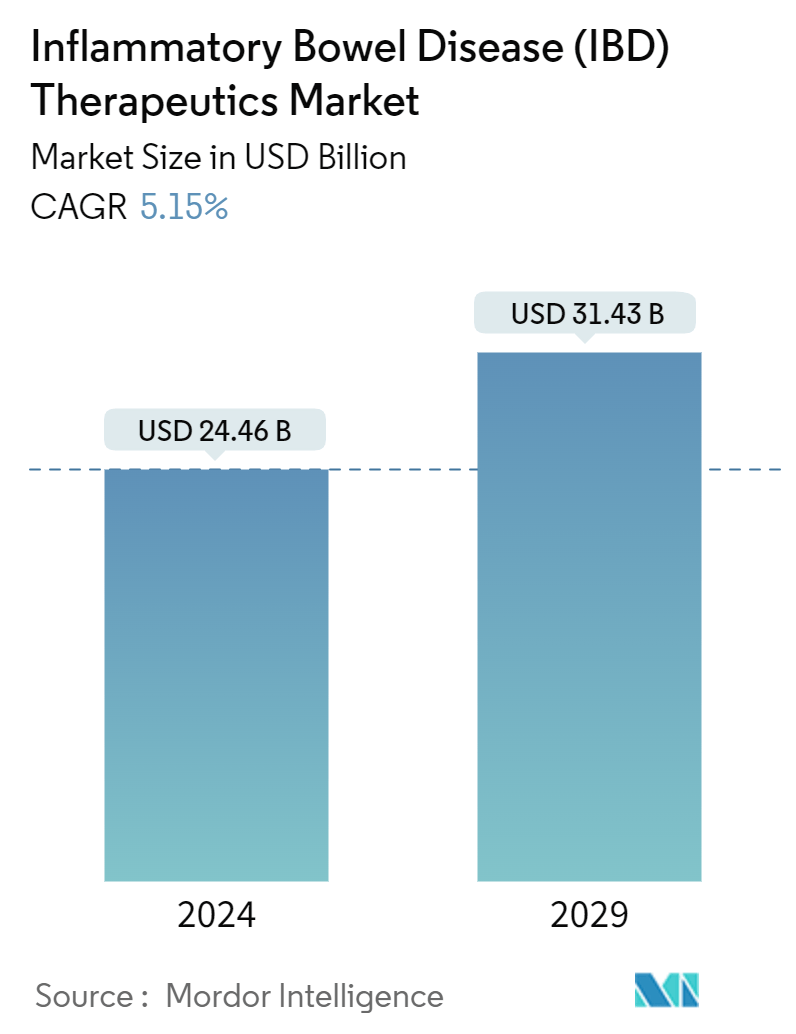
| Study Period | 2019 - 2029 |
| Market Size (2024) | USD 24.46 Billion |
| Market Size (2029) | USD 31.43 Billion |
| CAGR (2024 - 2029) | 5.15 % |
| Fastest Growing Market | Asia-Pacific |
| Largest Market | North America |
Major Players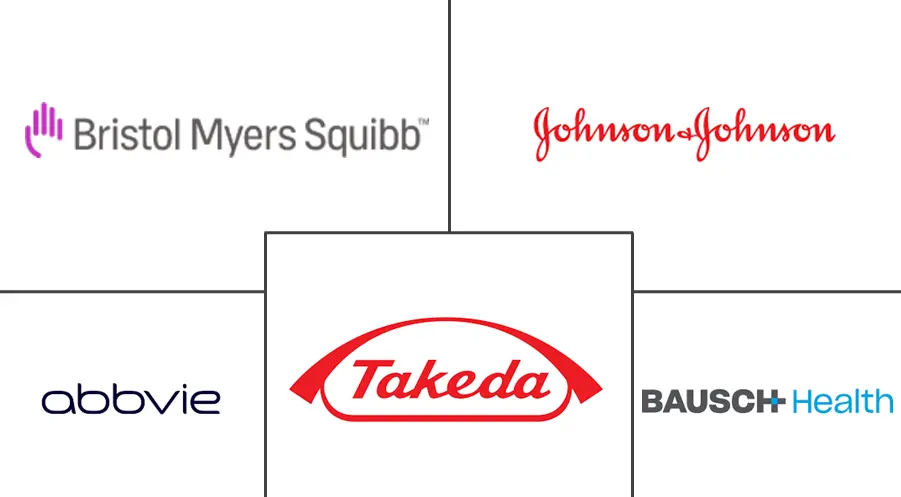
*Disclaimer: Major Players sorted in no particular order |
Inflammatory Bowel Disease (IBD) Therapeutics Market Analysis
The Inflammatory Bowel Disease Therapeutics Market size is estimated at USD 24.46 billion in 2024, and is expected to reach USD 31.43 billion by 2029, growing at a CAGR of 5.15% during the forecast period (2024-2029).
With the rise of COVID-19, there was a rise in other complications associated with IBD, such as Crohn’s disease (CD) and ulcerative colitis, that arise along with the infection. For instance, according to a report by the Surveillance Epidemiology of Coronavirus Under Research Exclusion (SECURE-IBD) database in January 2022, adverse COVID-19 outcomes were associated with age and other co-morbidities among patients with IBD. The novel severe acute respiratory syndrome-related coronavirus, upon entering the gastrointestinal tract, initiates activation of innate and adaptive immune responses. The onset of inflammatory reactions can supposedly induce intestinal damage in IBD patients. Thus, there was an increased demand for IBD therapeutics to manage further complications that could develop due to COVID-19. However, as the pandemic has subsided currently, the studied market is expected to have stable growth during the forecast period of the study.
The increasing occurrence of Crohn’s disease and ulcerative colitis is the major driver, which is predicted to boost the growth of the market. For instance, according to the data updated by Crohn’s & Colitis United Kingdom in 2022, it is estimated that 1 in every 123 people in the United Kingdom have either Crohn’s disease or ulcerative colitis, which amounts to a total of nearly half a million people in the United Kingdom living with IBD. The source also stated that research conducted in the United Kingdom also suggested that there is a significant chance of comorbidity between IBD and other inflammatory diseases, which means that people who have already received a diagnosis of IBD are more likely to be diagnosed with other inflammatory diseases in the future. Thus, the high burden of IBD is expected to boost the usage of its therapeutics during the forecast period.
An increase in the approval of biologics and the presence of robust pipeline products are expected to propel the growth of the market. For instance, according to an article published by the World Journal of Clinical Cases in April 2023, biologic agents have been widely used in the management of inflammatory bowel disease (IBD) for many years, and currently, there has been increasing interest and experience using dual biologic therapy (DBT) in IBD, primarily in difficult to treat and refractory cases with high disease burden. The increasing use of biologic therapies in IBD patients provides lucrative opportunities for market growth attributed to the vast costs of biologics.
However, a lack of awareness among people about IBD is expected to limit the growth of the market.
Inflammatory Bowel Disease (IBD) Therapeutics Market Trends
The JAK inhibitors Segment is Expected to Hold a Significant Market Share in the Inflammatory Bowel Disease (IBD) Therapeutics Market.
The Janus Kinase (JAK) inhibitors are a major fraction of the drug classes used in the treatment of IBD. For instance, according to an article published by Drugs in March 2023, Janus kinase (JAK) inhibitors are widely used for the treatment of IBD. The source also stated that JAKs such as tofacitinib, a non-selective small molecule JAK inhibitor, and upadacitinib and filgotinib, which are selective JAK-1 inhibitors, have been approved by the United States Food and Drug Administration (FDA) for moderate-to-severe active ulcerative colitis. Thus, the usage of JAK inhibitors in treating IBD is expected to boost segment growth.
Recently, combination therapies have been studied as a crucial resource for the treatment of refractory IBD. For instance, as discussed in an article published by Gastroenterology & Hepatology in January 2023, JAK inhibitors, in combination with other biological treatment methods, have illustrated an adequate safety profile and comparatively good efficacy in the treatment of IBD.
Significant discoveries in the treatment of IBD, especially the use of biologics, are expected to increase the Inflammatory Bowel Disease (IBD) Therapeutics market. JAK inhibitors, often known as oral biologics, are antibodies that are synthesized in vivo that act specifically by stopping certain inflammation-causing proteins. There is a large importance placed on the research of using JAK inhibitors and the magnitude of the research work being done on further combination therapy is substantial. These factors are expected to have a significant impact on the growth of the IBD treatment market in the upcoming period.
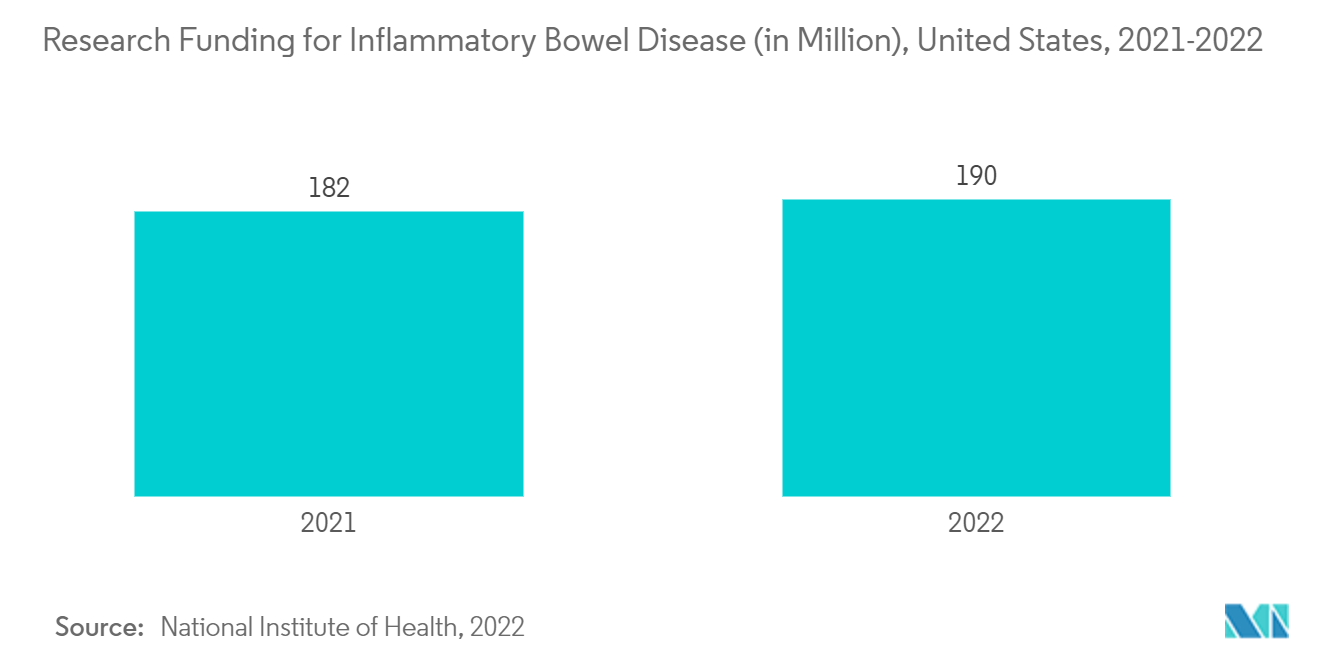
North America is Expected to Hold a Significant Share in the Market and Expected to do Same in the Forecast Period.
North America is expected to experience growth during the forecast period of the study due to factors such as the rising prevalence of IBD, the strong foothold of key market players in the country, and the rising research and development activities by pharmaceutical and biopharmaceutical companies for the development of IBD therapeutics. According to the data published by Crohn's and Colitis Canada and Pfizer Canada in November 2022, it was estimated that over 300,000 Canadians were believed to be living with IBD in 2022. By 2030, that number is expected to rise to 403,000 (1 in 100 people). Thus, the high burden of IBD in Canada is expected to boost market growth.
Furthermore, according to an article updated by NCBI in June 2022, North American incidence of inflammatory bowel disease (IBD) ranges from 2.2 to 19.2 cases per 100,000 person-years for ulcerative colitis and 3.1 to 20.2 cases per 200,000 person-years for CD. Thus, the high prevalence of IBD is expected to boost the demand for therapeutics for IBD during the forecast period. Hence, the abovementioned factors, such as the rising prevalence of IBD, are expected to enhance the market growth in the region over the forecast period.
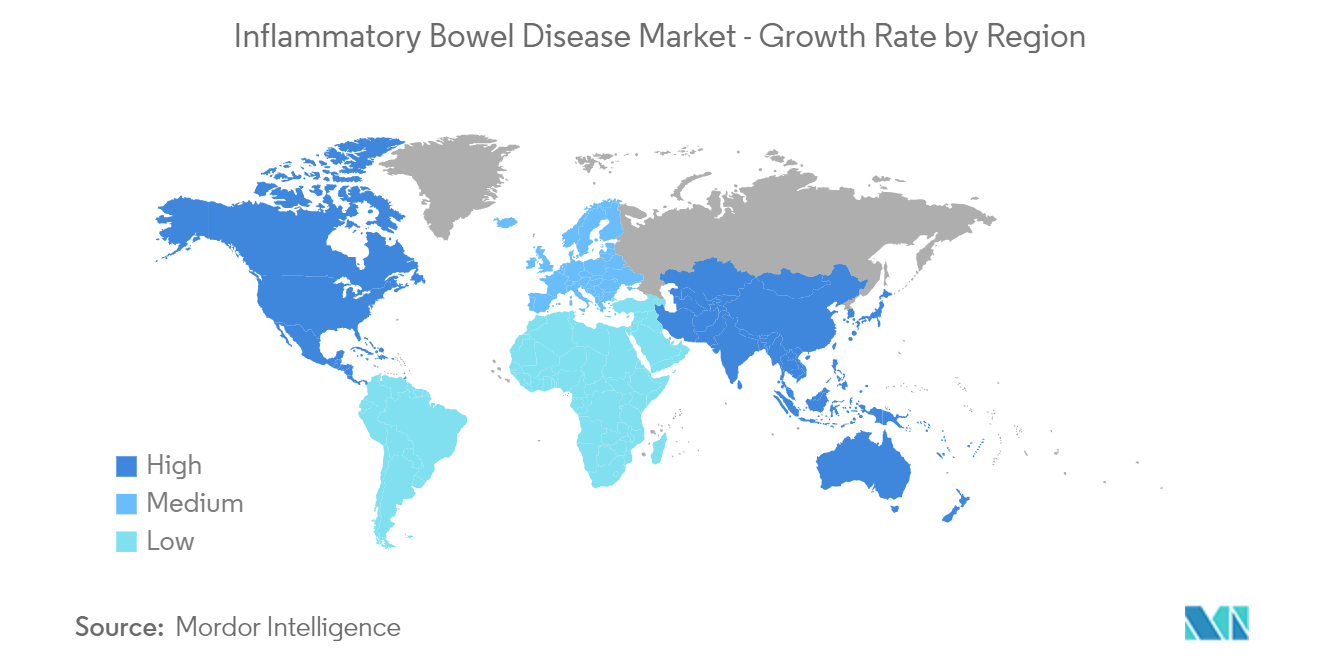
Inflammatory Bowel Disease (IBD) Therapeutics Industry Overview
The inflammatory bowel disease (IBD) therapeutics market is fragmented and competitive and consists of several major players. In terms of market share, a few of the major players are currently dominating the market. Some of the companies that are currently dominating the market are Bristol-Myers Squibb Company, AbbVie Inc., Allergan Therapeutics LLC, Bausch Health Companies Inc. (Salix Pharmaceuticals), Rare Disease Therapeutics Inc., Johnson & Johnson Services Inc., Janssen Biotech, Inc., UCB Inc., and others.
Inflammatory Bowel Disease (IBD) Therapeutics Market Leaders
-
Bristol-Myers Squibb Company
-
AbbVie Inc.
-
Takeda Pharmaceutical Company Limited
-
Johnson & Johnson Services Inc. (Janssen Biotech, Inc.)
-
Bausch Health Companies Inc. (Salix Pharmaceuticals)
*Disclaimer: Major Players sorted in no particular order
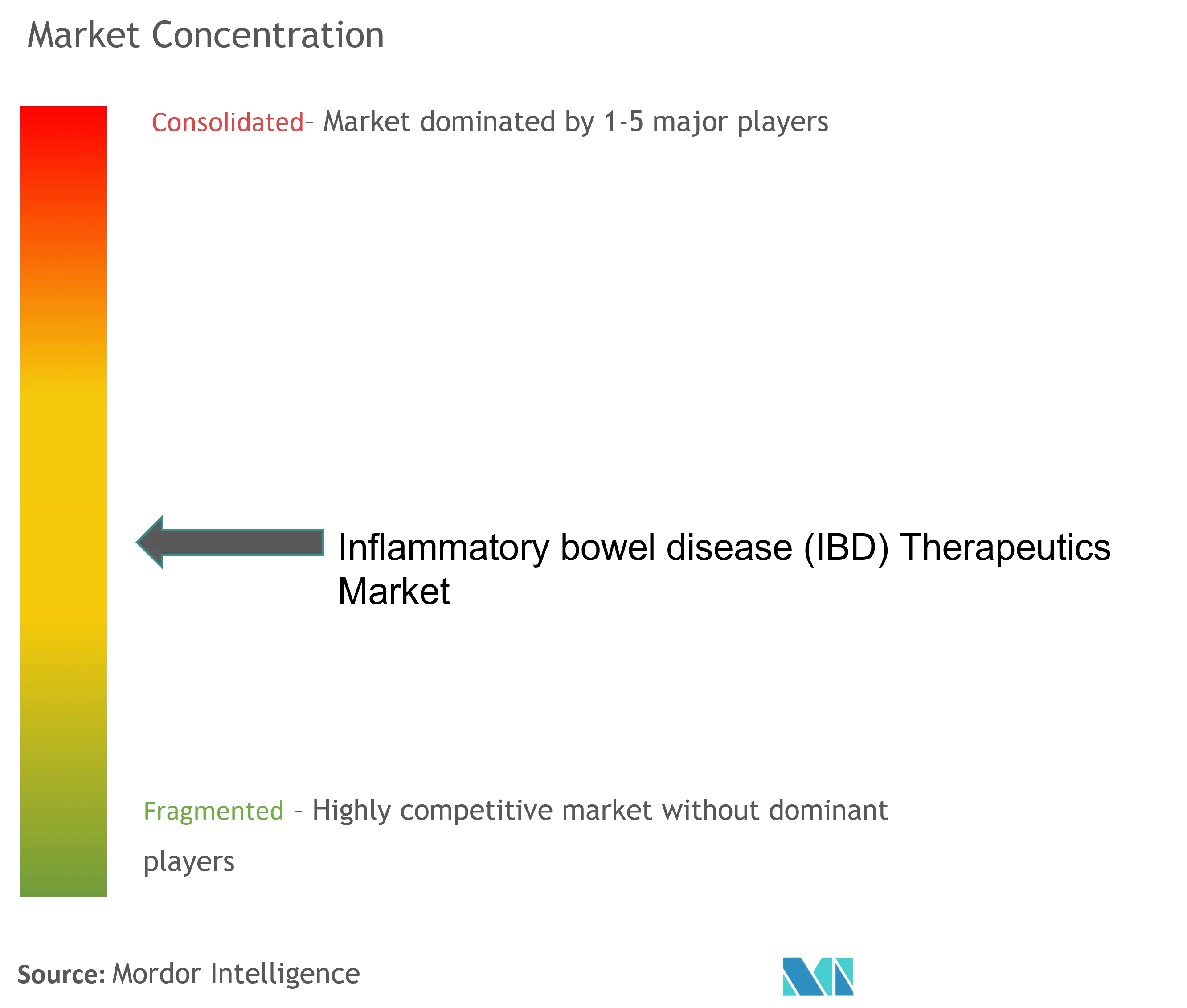
Inflammatory Bowel Disease (IBD) Therapeutics Market News
- June 2022: AbbVie announced that the United States FDA had approved SKYRIZI (risankizumab-rzaa) as an interleukin-23 (IL-23) inhibitor for the treatment of adults with moderately to severely active Crohn’s disease (CD).
- April 2022: Bristol Myers Squibb Canada (BMS) announced that Health Canada approved ZEPOSIA (ozanimod) capsules for the treatment of adult patients with moderately to severely active ulcerative colitis (UC) who have had an inadequate response, loss of response, or was intolerant to either conventional therapy or a biologic agent. UC is a chronic inflammatory bowel disease (IBD) affecting the large intestine (colon).
Inflammatory Bowel Disease (IBD) Therapeutics Market Report - Table of Contents
1. INTRODUCTION
- 1.1 Study Assumptions and market definition
- 1.2 Scope of the Study
2. RESEARCH METHODOLOGY
3. EXECUTIVE SUMMARY
4. MARKET DYNAMICS
- 4.1 Market Overview
-
4.2 Market Drivers
- 4.2.1 Increasing Research on IBD Treatment
- 4.2.2 Increasing Occurrence of Crohn's Disease and Ulcerative Colitis
-
4.3 Market Restraints
- 4.3.1 Strict Drug Regulatory Policies
- 4.3.2 Lack of awareness among people
-
4.4 Porter's Five Forces Analysis
- 4.4.1 Bargaining Power of Suppliers
- 4.4.2 Bargaining Power of Buyers/Consumers
- 4.4.3 Threat of New Entrants
- 4.4.4 Threat of Substitute Products
- 4.4.5 Intensity of Competitive Rivalry
5. MARKET SEGMENTATION (Market Size by Value – USD)
-
5.1 By Disease
- 5.1.1 Crohn's disease
- 5.1.2 Ulcerative colitis
-
5.2 By Drug Class
- 5.2.1 TNF inhibitors
- 5.2.2 JAK inhibitors
- 5.2.3 Aminosalicylates
- 5.2.4 Corticosteroids
- 5.2.5 Other Drug Classes
-
5.3 By Route of administration
- 5.3.1 Oral
- 5.3.2 Parenteral
-
5.4 By End User
- 5.4.1 Hospital pharmacies
- 5.4.2 Online pharmacies
- 5.4.3 Retail pharmacies
-
5.5 Geography
- 5.5.1 North America
- 5.5.1.1 United States
- 5.5.1.2 Canada
- 5.5.1.3 Mexico
- 5.5.2 Europe
- 5.5.2.1 Germany
- 5.5.2.2 United Kingdom
- 5.5.2.3 France
- 5.5.2.4 Italy
- 5.5.2.5 Spain
- 5.5.2.6 Rest of Europe
- 5.5.3 Asia-Pacific
- 5.5.3.1 China
- 5.5.3.2 Japan
- 5.5.3.3 India
- 5.5.3.4 Australia
- 5.5.3.5 South Korea
- 5.5.3.6 Rest of Asia-Pacific
- 5.5.4 Middle East and Africa
- 5.5.4.1 GCC
- 5.5.4.2 South Africa
- 5.5.4.3 Rest of Middle East and Africa
- 5.5.5 South America
- 5.5.5.1 Brazil
- 5.5.5.2 Argentina
- 5.5.5.3 Rest of South America
6. COMPETITIVE LANDSCAPE
-
6.1 Company Profiles
- 6.1.1 Bristol-Myers Squibb Company
- 6.1.2 AbbVie Inc.
- 6.1.3 Allergan Therapeutics LLC
- 6.1.4 Bausch Health Companies Inc. (Salix Pharmaceuticals)
- 6.1.5 Rare Disease Therapeutics Inc.
- 6.1.6 Johnson & Johnson Services Inc.
- 6.1.7 UCB Inc.
- *List Not Exhaustive
7. MARKET OPPORTUNITIES AND FUTURE TRENDS
** Subject To AvailablityInflammatory Bowel Disease (IBD) Therapeutics Industry Segmentation
As per the scope of the report, inflammatory bowel disease (IBD) is characterized by chronic inflammation of the gastrointestinal (GI) tract. The two classifications of IBD are Crohn’s disease and ulcerative colitis. Prolonged inflammation can cause damage to the GI tract. The Inflammatory Bowel Disease (IBD) therapeutics market is segmented by disease type (Crohn’s disease and ulcerative colitis), drug class (TNF inhibitors, JAK inhibitors, aminosalicylates, corticosteroids, and other drug classes), route of administration (oral and parenteral), end user (hospital pharmacies, online pharmacies, and retail pharmacies), and geography (North America, Europe, Asia-Pacific, Middle East and Africa, and South America). The market report also covers the estimated market sizes and trends of 17 countries across major regions globally.
The report offers values in (in USD) for the above segments.
| By Disease | Crohn's disease | |
| Ulcerative colitis | ||
| By Drug Class | TNF inhibitors | |
| JAK inhibitors | ||
| Aminosalicylates | ||
| Corticosteroids | ||
| Other Drug Classes | ||
| By Route of administration | Oral | |
| Parenteral | ||
| By End User | Hospital pharmacies | |
| Online pharmacies | ||
| Retail pharmacies | ||
| Geography | North America | United States |
| Canada | ||
| Mexico | ||
| Geography | Europe | Germany |
| United Kingdom | ||
| France | ||
| Italy | ||
| Spain | ||
| Rest of Europe | ||
| Geography | Asia-Pacific | China |
| Japan | ||
| India | ||
| Australia | ||
| South Korea | ||
| Rest of Asia-Pacific | ||
| Geography | Middle East and Africa | GCC |
| South Africa | ||
| Rest of Middle East and Africa | ||
| Geography | South America | Brazil |
| Argentina | ||
| Rest of South America |
Inflammatory Bowel Disease (IBD) Therapeutics Market Research FAQs
How big is the Inflammatory Bowel Disease Therapeutics Market?
The Inflammatory Bowel Disease Therapeutics Market size is expected to reach USD 24.46 billion in 2024 and grow at a CAGR of 5.15% to reach USD 31.43 billion by 2029.
What is the current Inflammatory Bowel Disease Therapeutics Market size?
In 2024, the Inflammatory Bowel Disease Therapeutics Market size is expected to reach USD 24.46 billion.
Who are the key players in Inflammatory Bowel Disease Therapeutics Market?
Bristol-Myers Squibb Company, AbbVie Inc., Takeda Pharmaceutical Company Limited, Johnson & Johnson Services Inc. (Janssen Biotech, Inc.) and Bausch Health Companies Inc. (Salix Pharmaceuticals) are the major companies operating in the Inflammatory Bowel Disease Therapeutics Market.
Which is the fastest growing region in Inflammatory Bowel Disease Therapeutics Market?
Asia-Pacific is estimated to grow at the highest CAGR over the forecast period (2024-2029).
Which region has the biggest share in Inflammatory Bowel Disease Therapeutics Market?
In 2024, the North America accounts for the largest market share in Inflammatory Bowel Disease Therapeutics Market.
What years does this Inflammatory Bowel Disease Therapeutics Market cover, and what was the market size in 2023?
In 2023, the Inflammatory Bowel Disease Therapeutics Market size was estimated at USD 23.20 billion. The report covers the Inflammatory Bowel Disease Therapeutics Market historical market size for years: 2019, 2020, 2021, 2022 and 2023. The report also forecasts the Inflammatory Bowel Disease Therapeutics Market size for years: 2024, 2025, 2026, 2027, 2028 and 2029.
Inflammatory Bowel Disease (IBD) Therapeutics Industry Report
Statistics for the 2024 Global Inflammatory Bowel Disease (IBD) Therapeutics market share, size and revenue growth rate, created by Mordor Intelligence™ Industry Reports. Global Inflammatory Bowel Disease (IBD) Therapeutics analysis includes a market forecast outlook to 2029 and historical overview. Get a sample of this industry analysis as a free report PDF download.



